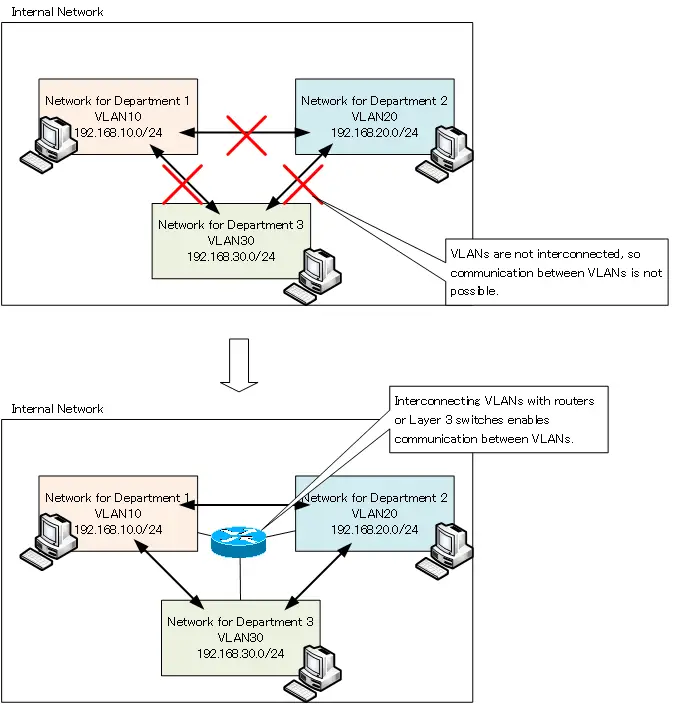Table of Contents
Inter VLAN routing overview
When a Layer 2 switch divides a network by VLANs, communication between different VLANs becomes impossible. You can freely decide how you want to divide the network. As a general example, in a company’s internal network, the network is often divided into departments, and if the network is divided into departments using VLANs and communication between the departments becomes impossible, it will naturally interfere with business operations. Since we are in the same company, we also need to communicate between departments, i.e., between VLANs.
If using a router, then router is dividing the network and interconnecting at the same time. Therefore, communication between different networks is possible. To enable communication between VLANs, VLANs must be interconnected, which is called “inter-VLAN routing”.
Layer 3 network devices such as routers and layer 3 switches are required to implement inter-VLAN routing.
A simple example of inter-VLAN routing
Let us consider a simple example of inter-VLAN routing. The following figure shows an example where an internal network is divided into three networks for each department by creating three VLANs with Layer 2 switch. The networks divided by the VLANs of the Layer 2 switch are not interconnected. Therefore, communication between VLANs, or departments, is not possible. Therefore, VLANs are interconnected by routers or Layer 3 switches. Then, communication between VLANs can be done through a router or a layer 3 switch.

VLAN(Virtual LAN)
- The need to divide the network
- Details of dividing the network
- VLAN Overview
- VLAN behavior
- Access port : Port assigned to only one VLAN
- Trunk port : Port assigned to multiple VLANs
- Summary of Trunk Protocols – IEEE802.1Q and ISL
- Native VLAN
- Specific example of native VLAN mismatch
- Cisco DTP
- Cisco Configuring and Verifying VLAN
- Cisco VLAN Detailed Configuration Example
- Notes on deleting VLANs
- Voice VLAN – VLAN for connecting IP phones
- VTP :Synchronize VLAN configuration
- VTP pruning – Stopping unnecessary flooding of trunk links
- Configuring and Verifying Cisco VTP
- Inter VLAN routing overview
- Inter-VLAN routing by router
- Inter-VLAN routing by Layer 3 switch
- Configuring and Verifying Inter-VLAN Routing by Cisco Router
- Cisco Configuring Inter-VLAN routing by Layer3 switch : SVI/routed port
- Cisco Layer3 Switch Basic Configuration Example
- Summary of Layer 3 Switch Port Concepts – Access Port/Trunk Port/SVI/Routed Port
- LAN Design pattern : 2-tier and 3-tier